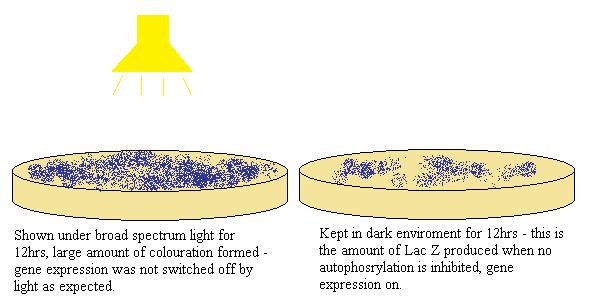Team:Sheffield/Project
From 2009.igem.org
| Home | Team | Project | Parts | Modeling | Notebook |
|---|
|
Overall projectIn this project, we originally intended to create an E.coli system that is sensitive to multiple wavelengths of light and produce a colour indication of the specific wavelength it is exposed to. However due to limitations in the time and number of people available, and due to unexpected results the project changed significantly.
Project DetailsThe first experiment we carried to familiarise ourselves with the strain, was to repeat the light sensing ability of RU1012 as described in the Levskaya et al. paper[1], in its most simple form. Red light switch off the photoreceptor through inhibiting autophosphorylation, and therefore switching off the expression for Lac Z production. We shown borad spectrum light on one sample and kept the other in the dark so that gene expression can not be interefered. The samples were put on seperate agar plates with X-gal on it which acts as a substrate for Lac Z and producing a blue colouration. To our surprise, the result were opposite to what we expected: the illuminated plate produced more pigment than the one in the dark, whereas it should have been the opposite. After that several experiments were carried to confirm if the result was systematic, and then to work the reason for this unusual result. Then, to quantitatively assess the activity rate of the beta-galactocidase depending on the intensity, the Miller Assay was used. After that, the results were analyzed and compared with the models. ResultsDiscussionFurther WorkDue to time restrictions, and the few people we had available for this project. We would to continue characterising the parts of this system, as well as repeat our the Miller assay for more values of light intensities and wavelengths. We also have the thought of new directions to develop the project after contacting Christopher A. Voigt. ReferencesPapers
|
 "
"

